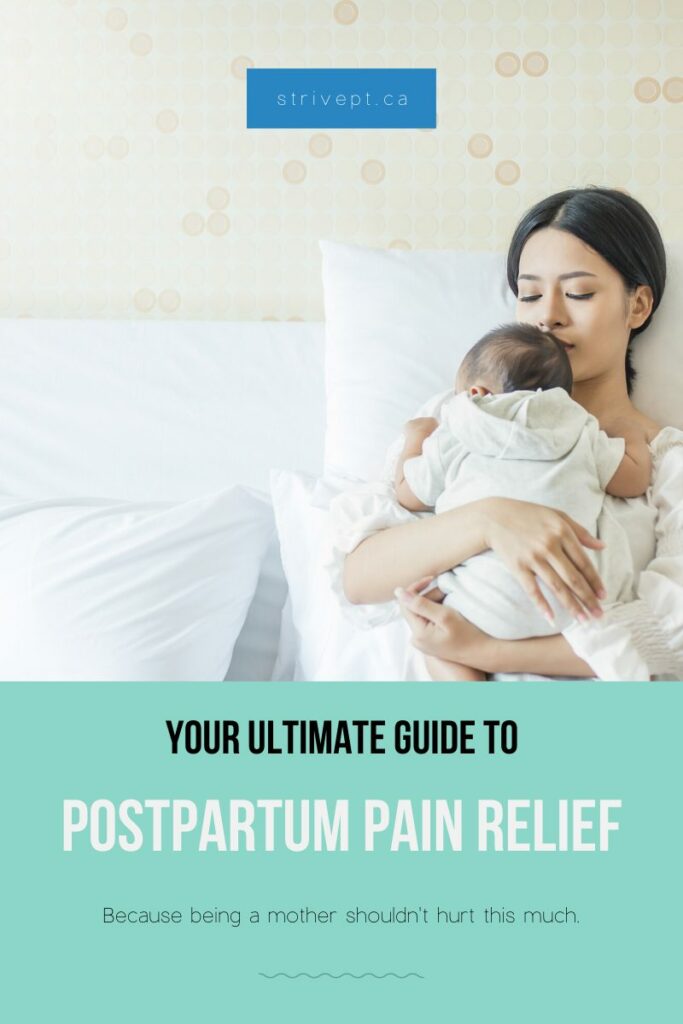
Being a new mom can be extremely hard. When you have so many new things happening like the hormonal changes, the body changes, the lifestyle changes, and the little bundle of joy screaming in your face at 4 AM, one thing you DON’T want to add on to this is body aches and pains.
I’m sure you have read lots of information in preparation for your new baby – You knew a bit of what you were getting into in terms of childbirth, you had your birthing plan, you took prenatal classes, and maybe you read every new parent book under the sun. You had every grandmother, aunt, and friend tell you their biggest tips for new parents in keeping their new baby happy and healthy. You’re doing the best that you can, but suddenly your neck is aching, or your wrist is hurting, but you have to get your baby fed, so you suck it up. But what if that aching is persisting?
We need to address that.
By managing your body aches and pains NOW, you can help prevent them from worsening and have more time and energy to focus on your little one. Because being a new mom shouldn’t hurt this much.
How to Make Breastfeeding More Comfortable
Learning how to breastfeed, and getting your baby to agree with your game plan, can be tough in of itself. But what about how your body is feeling while you’re breastfeeding?
If you’re finding that your body is really sore after, chances are we need to adjust how you’re doing it – for YOUR comfort, not just your baby’s. After all, babies need to eat frequently, and take a while to eat… which means you may be in the same position for a lot of your day! Even if you are bottle feeding, similar principles apply – you need to get comfy!
If you are having mild pain, you may have to take less drastic measures in adjusting your position. If you are having severe pain (ie. sharp, shooting pain) while breastfeeding, you need to address this NOW, to ensure you can focus on taking care of your baby.
I’m going to assume that you have the breastfeeding technique somewhat down. If you’re having issues, may I suggest a lactation consultant to assist you and your baby? The easier it is for you and your baby to get the job done, the more you’ll be able to focus on how you’re feeling.
Now let’s take a visual look at two different breastfeeding set ups, and some quick pointers :
- Nooooooo
In this picture, we have multiple areas of concern which may or may not be causing discomfort.
- Neck held in a looking down position
- Arms physically holding the baby up, no support
- Slumped position, with an unsupported back
- Curled in wrists
- Yes!
- Neck looking forward, and supported for optimal relaxation (if needed)
- Arms supported with pillows, minimal prolonged muscle contraction required
- Back supported upright, extra lumbar support for comfort
- Wrists in more neutral and relaxed position
- Bonus : heating pad on neck for extra muscle relaxation during breastfeeding
The full story :
When you are first learning to breastfeed, it can be tricky. That may lead you to getting used to looking down at your baby all the time while they’re feeding. This can put a strain on your neck which may become uncomfortable over time.
Once your baby is latched, relax your head back into a neutral position. This will relax the muscles in your neck and give them a nice break. Alternatively, if your baby requires a lot of monitoring to get the job done, you can take breaks from looking down to look all the way up to the ceiling every minute or two.
You can absolutely use a breastfeeding or nursing pillow to help prop your baby up to the right spot, BUT you can also use any other pillows you have around the house to help get your body in a comfortable position. But let your arms relax! You will be holding your baby quite a lot, so any time that you can relax your arms may be beneficial.
I hope that you have a nice comfy area set up to breastfeed in. However, sometimes couches and chairs can be too comfy and allow you to sink into it too much! If you’re finding that your back is struggling after breastfeeding, consider adding extra lumbar support behind your lower back. This could mean just a couch pillow shoved behind your lower back to help prop up your normal lumbar curve while sitting on your nice cushy seat.
If your baby is supported with a pillow, and your arms aren’t having to do much, chances are your wrists will be able to take a break too. Try to adjust your position so that your wrists are in a neutral position, instead of a really bent position. This will help ease the strain on your hand and forearm muscles.
I hope you have a heating pad already hanging around the house. Heating pads are awesome for relaxing tense muscles in problem areas. I know it can be tough to find time to sit and relax with a heating pad for 20 minutes when you have a new baby (especially if you have other little ones after your attention!). If you can get it set up to be on while you’re breastfeeding, then you can multi-task! Alternatively – have a steaming hot shower to relax all your muscles for 15 minutes while your significant other or family members are watching the kids.
**Safety warning – no falling asleep with a heating pad on!
Ultimately, breastfeeding doesn’t have to look this comfortable ALL the time… If it’s the middle of the night, just get the job done! But when you do have some time to set this up for yourself (or a helpful significant other or family member to help you position the pillows and find the extension cord for the heating pad they dug out of the bottom of your closet), I think you will find that breastfeeding can be more relaxing. The above tips also apply if you’re just sitting and holding your baby.
When you’re changing your body’s demands so suddenly (prenatally versus postpartum) in terms of your daily activities, sometimes you need to ease yourself into it to allow your body time to adapt to this new routine.
Carrying Your Child Around
Baby wearing, or using a baby wrap/carrier, seems to be a great way to multi-task for moms. Instead of taking up one or both arms carrying your baby, have both hands free to do whatever you need to do while your baby is cosy on your chest! Just make sure you’re standing tall when you are using a carrier or a wrap.
Another consideration is how long you’re wearing them for – start with 5-10 minutes, and see how you feel. If all goes well, increase the time you’re wearing them slowly to allow your back muscle to adapt to this load!
If you are using your arms to hold them, sway them, bounce them, or burp them, consider a few things:
- Are you letting your shoulders slump forward all the time?
- Are you excessively curling your wrists in?
- Have you been in the same position for a while? (>10 minutes… hours…?)
- Can you feel your muscles getting tired or achy?
If yes, consider changing your holding position by changing arms, or adjusting your position to use just your forearms and less of your hands to hold them. Take a break by handing your little one off to your significant other, putting them down in a safe place, or by taking a seat and using pillows to find a more restful position.
Troubleshooting your problem areas :
All moms will have a different experience, and that includes body aches and pains! Not everyone will have all of these problems, so if you don’t seem to be having any trouble, continue doing what you’re doing! Skip down to the body area that applies to you!
Upper back pain/Shoulder pain
- Aggravating activities may include holding your baby for prolonged periods of time, breastfeeding or bottle feeding in a slumped position, and changing diapers (leaning forward)
- Solutions :
- Take breaks from holding your baby if getting achy
- Sit up tall while feeding and relax back instead of slumping forward
- Raise your diaper changing station up higher
- Keep your baby close to you when going to lift them up
- Use a heating pad for 15 minutes at a time throughout the day to relieve tightness
- Exercises to relieve and prevent pain : Thoracic spine foam rolling, side-lying thoracic spine rotations, scapular retractions
Lower back pain
- Aggravating activities may include holding your baby for prolonged periods of time, breastfeeding or bottle feeding in a “too cushy” chair, bathing your baby, changing diapers (leaning forward), and bending to lift up your baby
- Solutions :
- Take breaks from holding your baby if getting achy
- Use lumbar support when sitting
- Bathe baby in a small tub on a raised surface instead of reaching down into the bathtub
- Raise your diaper changing station up higher
- Keep your baby close to you when lifting them
- Exercises to relieve and prevent pain : supine rotation, pelvic tilt
Wrist pain
- Aggravating activities may include holding your baby for prolonged periods of time, and breastfeeding or bottle feeding
- Solutions :
- Monitor your wrist position and bring it into a more neutral (less bent) position when feeding
- Use your forearms to hold your baby to your chest versus putting all the strain on your hands
- Exercises to relieve and prevent pain : Wrist Figure 8s
Neck pain
- Aggravating activities may include prolonged looking down while feeding or holding your baby, and sitting with slumped posture
- Solutions :
- Take breaks from looking down while feeding or holding your baby to look up
- Allow your head to relax back against a pillow to relax even further
- Use lumbar support to prevent a prolonged slumped sitting posture
- Exercises to relieve and prevent pain : Neck extensions, Neck side bends
Knee pain
- Aggravating activities may include sitting with your legs crossed, or side sitting (with both legs bent out on one side ; standing up from a chair or climbing stairs
- Solutions :
- Avoid twisting positions for your knees – sitting with your legs crossed, especially with your child’s weight on top of your knee
- Strengthen your leg muscles!
- Exercises to relieve and prevent pain : knee pumping, sit to stand
The above exercises are basic exercises to get things moving that most mom’s will be able to do. I recommend doing them as frequently as you need to – if that’s 10 times per day, or if that’s just once at the end of the day, great! Do what works best for you. If you are already in a lot of pain, consider doing less range of motion with each movement – meaning don’t push as far with each exercise.
Returning to exercise after pregnancy:
Whether you had a vaginal delivery or a Caesarean delivery, you may find that giving birth took a toll on your body. But what if we could build our bodies up to make us stronger and more resilient, and less likely to be bothered by prolonged positioning? And also make us less fatigued by the increased baby lifting that we’re doing? And benefit our physical and mental health?
That’s where exercise comes in!
The American College of Obstetricians and Gynaecologists suggests 150 minutes of moderate intensity aerobic activity per week plus 2 days of resistance training postpartum. (This isn’t different from what the World Health Organization suggests for ALL OF US!)
If you’re exhausted and can’t imagine having the time to do anything for yourself, then keep reading.
May I suggest a walk to start?
Try to go for a walk outside every day. Or three.
You may feel tired at first – start with a two minute walk and see how you feel. If you can find a short walking “circuit” that goes by your house, you can do laps and track your endurance improving day after day – all while not being too far from home. You can bring your baby with you to get some fresh air, or leave your baby at home with your partner or family member.
If you were exercising through your pregnancy (which I highly recommend), you may have found that your intensity and duration decreased as you approached your delivery date. After delivery, you will find that you will continue to need to decrease the intensity and duration of your workouts compared to what you would have done before you were pregnant. Walking is a great precursor exercise to getting into more intense aerobic and resistance training exercise.
It is important to have a gradual return to your previous exercise level that is relatively pain free. If something is hurting, you may need to start with a modified version of the exercise you’re doing, or consult a physiotherapist for personalized advice. Your first step back into an exercise routine should not be high intensity, ballistic exercise (ie. any type of jumping, sprinting, burpees, or situps!). While this type of exercise can be returned to eventually, you should build up your body’s basic aerobic ability and strength over a few months (or more if needed!) before returning to these higher intensity movements. Your core muscles in particular may have a much lower tolerance for exercise than they used to, due to the stretching of the abdominal muscles and changes in your pelvic floor during pregnancy.
Caesarean specific information :
You may have a more prolonged recovery if you had a Caesarean “C-section” delivery. It may take 4-8 weeks to resume your normal household activities. You may have been told to avoid lifting more than your baby, avoid heavy household chores, and to avoid abdominal exercises. You should take it easy, but that doesn’t mean bedrest! Feel free to slowly increase your walking and perform light household tasks based on your tolerance. Ensure you follow your doctor’s specific instructions for you regarding your activity level based on your surgical experience and complications (if applicable). Typically your follow up appointments with your doctor/OBGYN in the first 6-8 weeks will make sure that your surgical site is healing well and that you are okay to resume more intense exercise. Having “clearance” that your surgical site has healed well doesn’t mean that suddenly your tolerance for activity is magically back to normal! You may have to continue to increase your activity level slowly.
There you have it! A quick guide for new moms who shouldn’t have to hurt so much!
Do you think you need some personalized help so being a mom doesn’t hurt so much? Call us at 519-895-2020, or use our online booking tool on www.strivept.ca to book an appointment with one of our knowledgeable physiotherapists, and they will be sure to help you understand how you can adjust your situation to help you feel better. Babies are welcome too!
Cheers,
Amanda McFadden
Physiotherapist at Strive Physiotherapy and Performance

